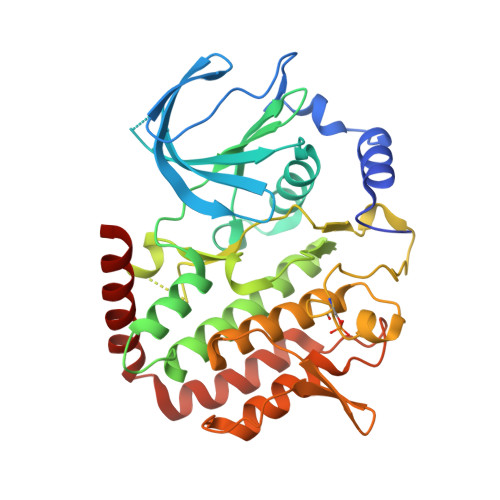Substrate-Specific Activation of the Mitotic Kinase Bub1 through Intramolecular Autophosphorylation and Kinetochore Targeting.
Lin, Z., Jia, L., Tomchick, D.R., Luo, X., Yu, H.(2014) Structure 22: 1616-1627
- PubMed: 25308863
- DOI: https://doi.org/10.1016/j.str.2014.08.020
- Primary Citation of Related Structures:
4QPM - PubMed Abstract:
During mitosis of human cells, the kinase Bub1 orchestrates chromosome segregation through phosphorylating histone H2A and the anaphase-promoting complex/cyclosome activator Cdc20. Bub1-mediated H2A-T120 phosphorylation (H2A-pT120) at kinetochores promotes centromeric sister-chromatid cohesion, whereas Cdc20 phosphorylation by Bub1 contributes to spindle checkpoint signaling. Here, we show that phosphorylation at the P+1 substrate-binding loop of human Bub1 enhances its activity toward H2A but has no effect on its activity toward Cdc20. We determine the crystal structure of phosphorylated Bub1. A comparison between structures of phosphorylated and unphosphorylated Bub1 reveals phosphorylation-triggered reorganization of the P+1 loop. This activating phosphorylation of Bub1 is constitutive during the cell cycle. Enrichment of H2A-pT120 at mitotic kinetochores requires kinetochore targeting of Bub1. The P+1 loop phosphorylation of Bub1 appears to occur through intramolecular autophosphorylation. Our study provides structural and functional insights into substrate-specific regulation of a key mitotic kinase and expands the repertoire of kinase activation mechanisms.
- Howard Hughes Medical Institute, University of Texas Southwestern Medical Center, 6001 Forest Park Road, Dallas, TX 75390, USA; Department of Pharmacology, University of Texas Southwestern Medical Center, 6001 Forest Park Road, Dallas, TX 75390, USA.
Organizational Affiliation:




















